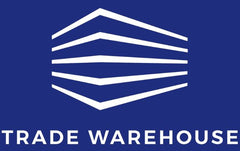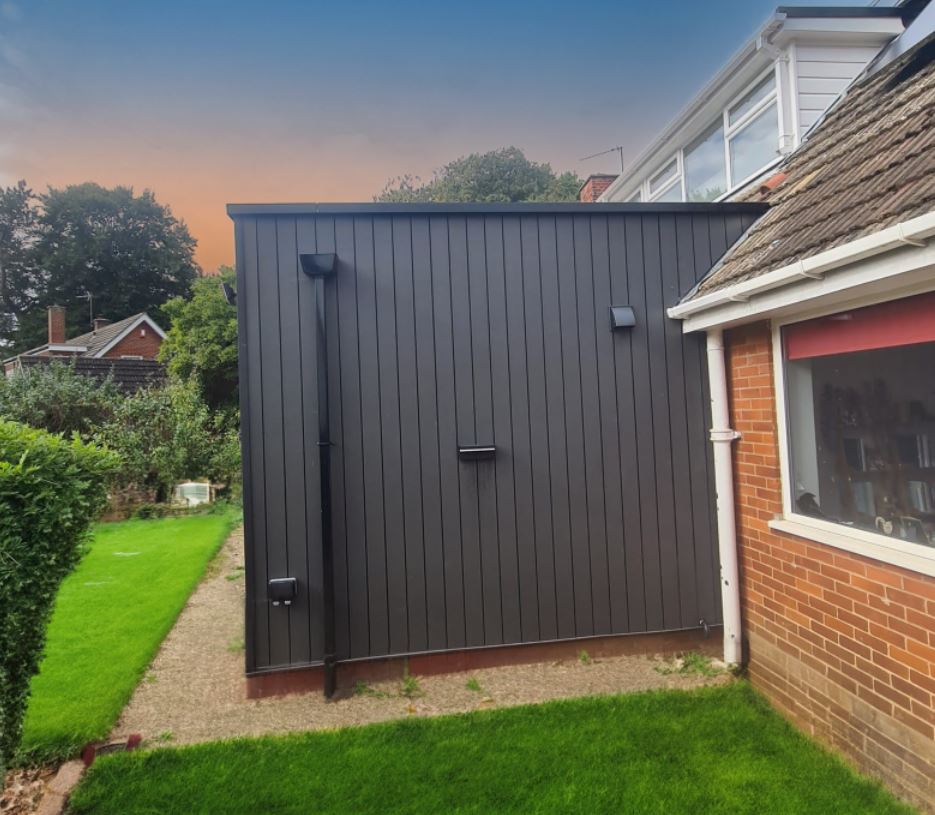Cladding plays a pivotal role in not just protecting a building but also enhancing its aesthetic appeal.
Here at Trade Warehouse, we are leading UK suppliers of both composite cladding, and fibre cement cladding.
Traditionally, timber used to be the primary choice, but advancements in material science have introduced more robust options like fibre cement and composite cladding.
These materials not only offer greater durability but also provide a structurally sound finish that outperforms traditional materials.

A customer using the plain charcoal composite cladding, supplied by Trade Warehouse
Understanding Your Materials:
Fibre Cement Cladding:
- Composition and Benefits: Composed of cement, sand, cellulose fibers, and other additives, this material is renowned for its weather resistance and longevity.
- Installation Considerations: Installation is more labour-intensive, requiring specialised skills for handling and fitting.
- Maintenance and Durability: Offers minimal maintenance needs and is resistant to many forms of decay.
Composite Cladding:
- Composition: This material blends recycled hardwood fibers with plastics, making it eco-friendly and durable.
- Ease of Installation: Known for its user-friendly installation with systems like tongue and groove (which we supply).
- Long-term Upkeep and Performance: Requires minimal maintenance and is resistant to rotting and warping.
Key Takeaway: When selecting cladding materials, consider both the physical properties and the installation demands of each type. Fibre cement offers longevity with less upkeep, while composite provides ease of installation and environmental benefits. 💡

A customer using the fibre cement cladding with the Tileform roof sheets.
Cost Analysis:
Examining the cost implications of fibre cement versus composite cladding is crucial for budget-conscious homeowners:
Initial Costs and Long-term Investments:
- Composite Cladding: Generally, composite cladding is more affordable upfront. Its materials and manufacturing processes are less costly, making it an attractive option for those looking to minimise initial expenses. However, while composite cladding is durable, it may not match the lifespan of fibre cement and could require replacement or repair sooner, especially in harsh environmental conditions.
- Fibre Cement Cladding: Although the initial purchase price and installation costs of fibre cement cladding are higher, its longevity and resilience often pay off. Fibre cement is less prone to damage from the elements, pests, or fire, which means it might not need to be replaced or repaired as often as other cladding types. Over time, these reduced maintenance and replacement costs can make fibre cement a more cost-effective choice in the long run.
Comparison of Installation Costs:
- Composite Cladding: The installation process for composite cladding is relatively straightforward, often involving simple mechanisms like clips or tongue and groove systems. This simplicity can significantly reduce labor costs, as it requires less specialized skill and can be accomplished more quickly, sometimes even as a DIY project.
- Fibre Cement Cladding: In contrast, fibre cement cladding usually requires professional installation. The boards are heavier and need careful handling and specific techniques for cutting and fitting. This not only increases the time taken to install but also boosts labor costs due to the higher level of skill and expertise required.
Key Takeaway: When evaluating cladding options, consider both the initial and long-term financial impacts. Composite cladding may offer savings upfront, but the enduring quality of fibre cement could provide greater financial benefits over the life of your home. It's important to factor in both the direct costs and the potential savings from reduced maintenance and longer lifespan. 💡
Installation Differences:
The installation process of cladding not only affects the timeline of your project but also significantly impacts the overall cost. Different cladding materials require varying levels of expertise and time commitments, which can influence your choice depending on your schedule and budget.
Fibre Cement Cladding:
-
Fibre cement cladding is notably heavier and more rigid than many alternative materials, necessitating specific handling and installation techniques. Its installation typically requires the skills of a professional who can manage its weight and the complexity of the installation process. The need for special tools to cut and fit the cladding precisely also adds to the labor intensity.
-
Due to its weight and the precision required in installation, installing fibre cement cladding is a meticulous process that involves securing the boards with screws or nails in a predefined pattern, which must account for expansion and contraction with changes in weather. This methodical approach ensures the cladding’s longevity and performance but increases the time and cost of installation.
Composite Cladding:
- In contrast, composite cladding is much lighter and often designed with user-friendly installation systems, such as tongue and groove or hidden clip systems. These features make it possible for even home DIY enthusiasts to handle and install the cladding, potentially saving on professional installation costs.
- The ease of cutting and fitting composite boards, coupled with their reduced weight, means that installation can be completed faster and with less labor compared to fibre cement. Many homeowners appreciate this as it not only cuts down on the cost but also accelerates the timeline of their renovation or building projects.
Key Takeaway: The choice of cladding material can greatly influence the complexity, duration, and cost of your installation project. If you prefer a quicker and potentially DIY installation, composite cladding offers a significant advantage. However, for those who prioritize durability and are prepared for a longer installation process, fibre cement cladding remains a worthwhile investment. Understanding these differences can help you make a more informed decision tailored to your specific needs and capabilities. 💡

One of our customers using the woodgrain composite cladding for their garden room.
Maintenance and Durability:
Durability and maintenance are crucial considerations when selecting cladding materials, as they directly affect both the longevity and the day-to-day appearance of the building's exterior.
Lifespan of Materials:
-
Fibre Cement Cladding: This material is renowned for its robust composition which includes cement, sand, and cellulose fibers, making it extremely durable against various environmental challenges. Fibre cement cladding is resistant to rot, fire, and termite damage, which contributes to its lengthy lifespan. Buildings clad with fibre cement can often go decades without needing major repairs or replacement, making it an excellent long-term investment.
- Composite Cladding: While composite cladding is designed to be durable and resistant to rot and pests, it generally does not match the lifespan of fibre cement. Its composition of recycled plastics and wood fibers makes it susceptible to fading and wear under extreme weather conditions. However, it still offers a considerable lifespan, which can be extended with proper care and maintenance.
Maintenance Requirements:
-
Fibre Cement Cladding: One of the biggest advantages of fibre cement cladding is its low maintenance. It does not require frequent painting or sealing, thanks to its inherent durability and resistance to weathering. Occasional cleaning to remove dirt and debris is typically all that’s needed to keep it looking its best.
- Composite Cladding: Composite cladding also boasts low maintenance requirements but tends to need more frequent cleaning to maintain its aesthetic appeal, especially in dusty or high-pollen environments. The surface of composite cladding can gather mold or mildew in particularly damp climates, thus requiring periodic washing with soapy water and a soft brush to restore its appearance.
Key Takeaway: When deciding between fibre cement and composite cladding, consider not only the initial aesthetic appeal but also the long-term durability and maintenance needs. Fibre cement is ideal for those looking for minimal upkeep and longevity, while composite cladding offers a balance of durability and ease of maintenance with more frequent cleaning. This understanding will help you choose a cladding solution that not only looks good but also stands the test of time in your specific environment. 💡
Aesthetic Considerations:
The choice of cladding can dramatically transform the visual appeal and curb appeal of your home. As such, aesthetic considerations are paramount when selecting a cladding material, with color options and textures playing a significant role in how the cladding integrates with the overall architectural style of your property.
Colour Options:
-
Fibre Cement Cladding: Cement board cladding offers a broad range of colours. It can mimic other materials like wood or stone, providing versatility in design. Whether you are aiming for a sleek, modern finish or a rustic charm, fibre cement can be tailored to meet these aesthetic goals. The ability to paint fibre cement in any color also allows for future changes in style without the need for complete replacement.
-
Composite Cladding: Similarly, composite cladding provides a variety of color choices and textures, which can include realistic wood grain patterns or smooth, contemporary finishes. Available in a spectrum of colours, from natural wood hues to bold, contemporary shades, composite cladding can be easily matched to any exterior paint or design theme.
Achieving Different Architectural Styles:
-
Fibre Cement Cladding: This type of cladding is especially popular for modern and minimalist designs due to its clean lines and smooth finish. However, it’s also adaptable enough to suit traditional homes, particularly when textured to mimic natural materials.
-
Composite Cladding: Composite is equally versatile, capable of complementing both traditional homes with its classic wood-like appearance and modern structures with its ability to form part of a sleek, uniform look. It’s an excellent choice for homeowners looking for flexibility and a consistently aesthetic façade.
Key Takeaway: Both fibre cement and composite cladding offer a wide range of aesthetic options, making them suitable for various architectural styles. When choosing your cladding, consider how the available colors and textures align with your design vision and how they might contribute to or detract from your property's overall aesthetic and market value. This consideration ensures that the cladding not only meets your practical needs but also enhances the beauty and appeal of your home. 💡
Environmental Impact:
Sustainable building practices are increasingly important in today's construction decisions.
- Sustainable Practices in Manufacturing: Composite cladding uses recycled materials, which helps reduce waste.
- Which Cladding is Greener? While composite cladding is beneficial for reducing waste, the long lifespan of fibre cement means less frequent material replacement.
Key Takeaway: Evaluate the environmental impact of your cladding choice, considering both the materials used and the longevity of the product. 💡
Final Thoughts - Our 2 Cents...
As we reflect on the distinctions and parallels between fibre cement and composite cladding, it's clear that both materials offer unique advantages that cater to different homeowner needs and preferences.
Making an informed choice involves weighing these differences in light of your specific circumstances and what you value most in a cladding solution.
Recap of Major Points:
- Cost-effectiveness: Composite cladding generally presents a lower initial cost, making it a budget-friendly option upfront. However, the longer lifespan and reduced maintenance needs of fibre cement can provide greater cost efficiency over time.
- Installation Ease: For those seeking a DIY-friendly option, composite cladding is advantageous due to its lighter weight and simpler installation methods. On the other hand, fibre cement, while requiring professional installation due to its weight and the complexity involved, offers unmatched durability and a refined aesthetic that might be worth the extra effort and expense.
- Environmental Impact: Composite cladding, made from recycled materials, tends to have a smaller immediate environmental footprint. Fibre cement, though more resource-intensive to produce, offers durability that could mean a lower overall environmental impact through reduced frequency of replacements.
Personal Recommendations Based on Various Scenarios:
- For homeowners in regions with extreme weather conditions, fibre cement’s superior resilience makes it an ideal choice.
- Those renovating on a tighter budget or with less exposure to severe weather might prefer the cost-effectiveness and ease of installation offered by composite cladding.
- Environmentally conscious homeowners might lean towards composite for its use of recycled materials, though they should also consider the long-term sustainability of more durable materials like fibre cement.
Comparison Table:


